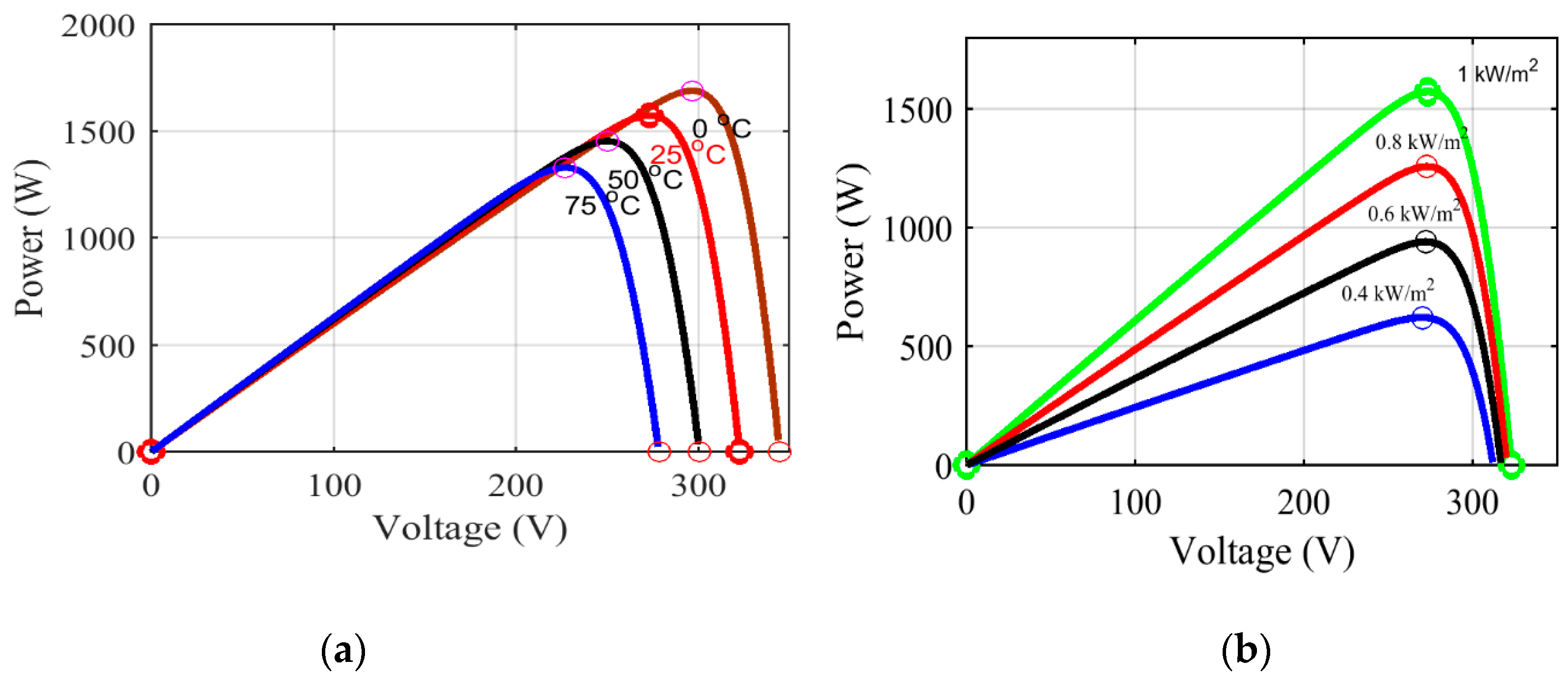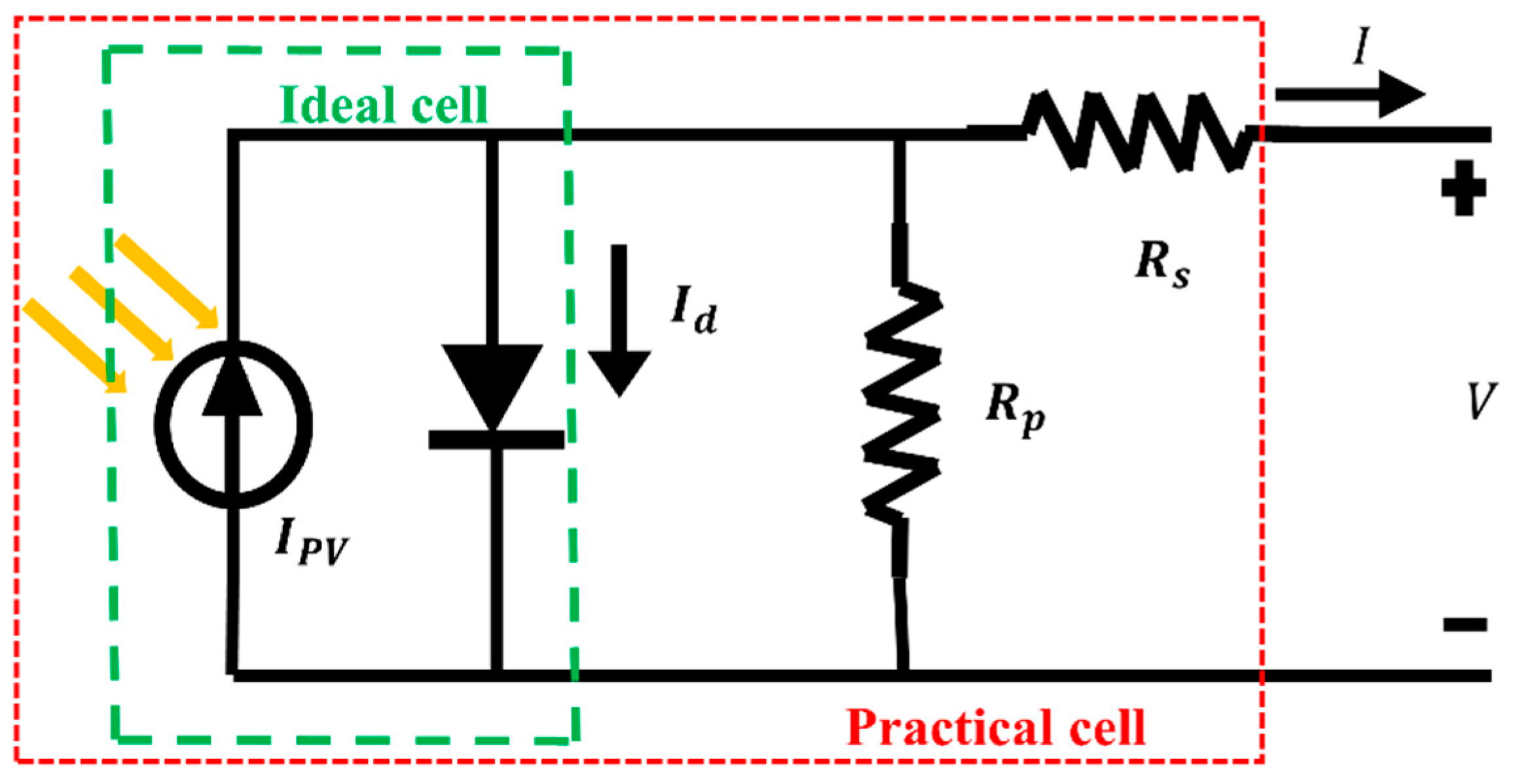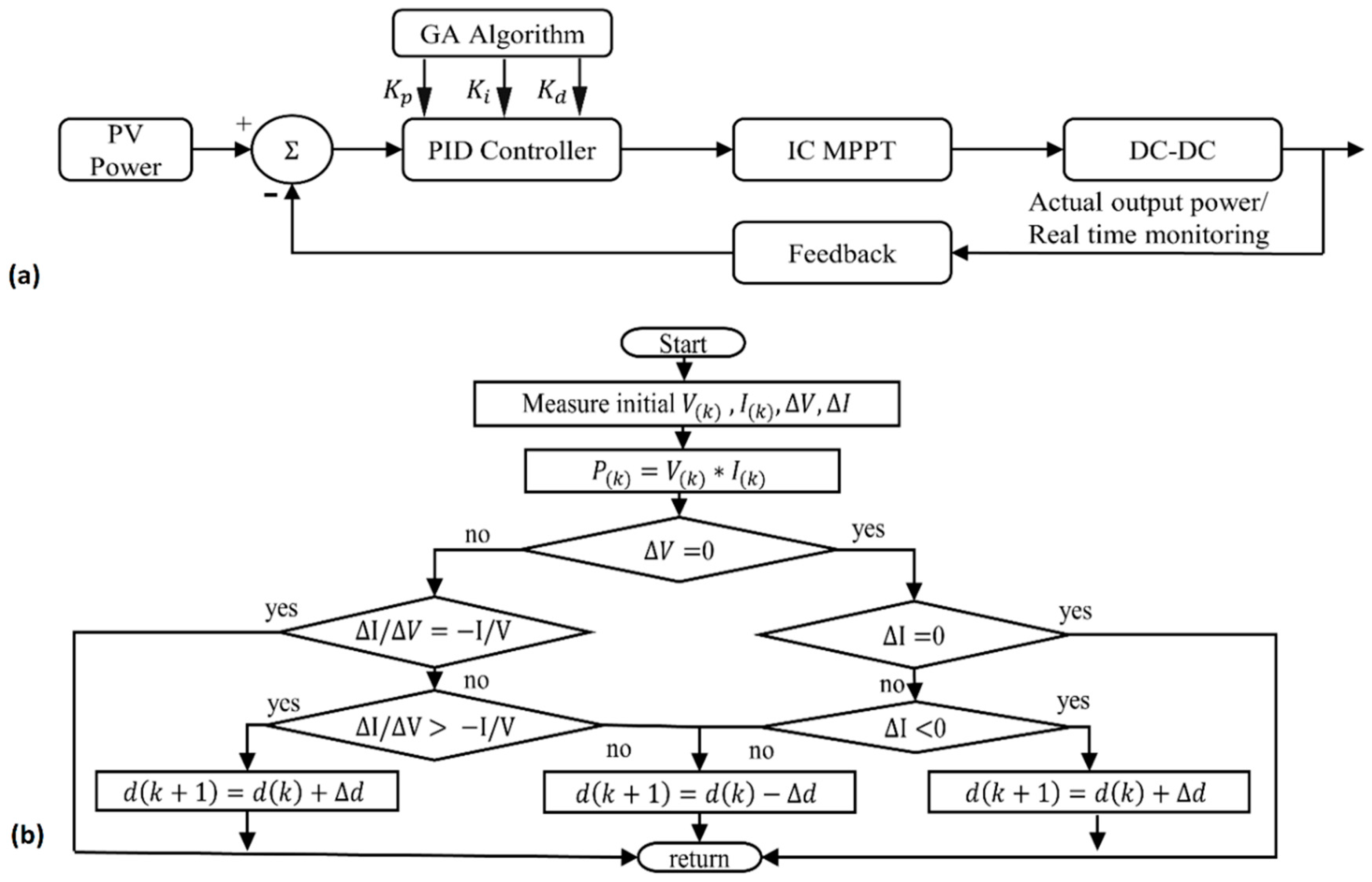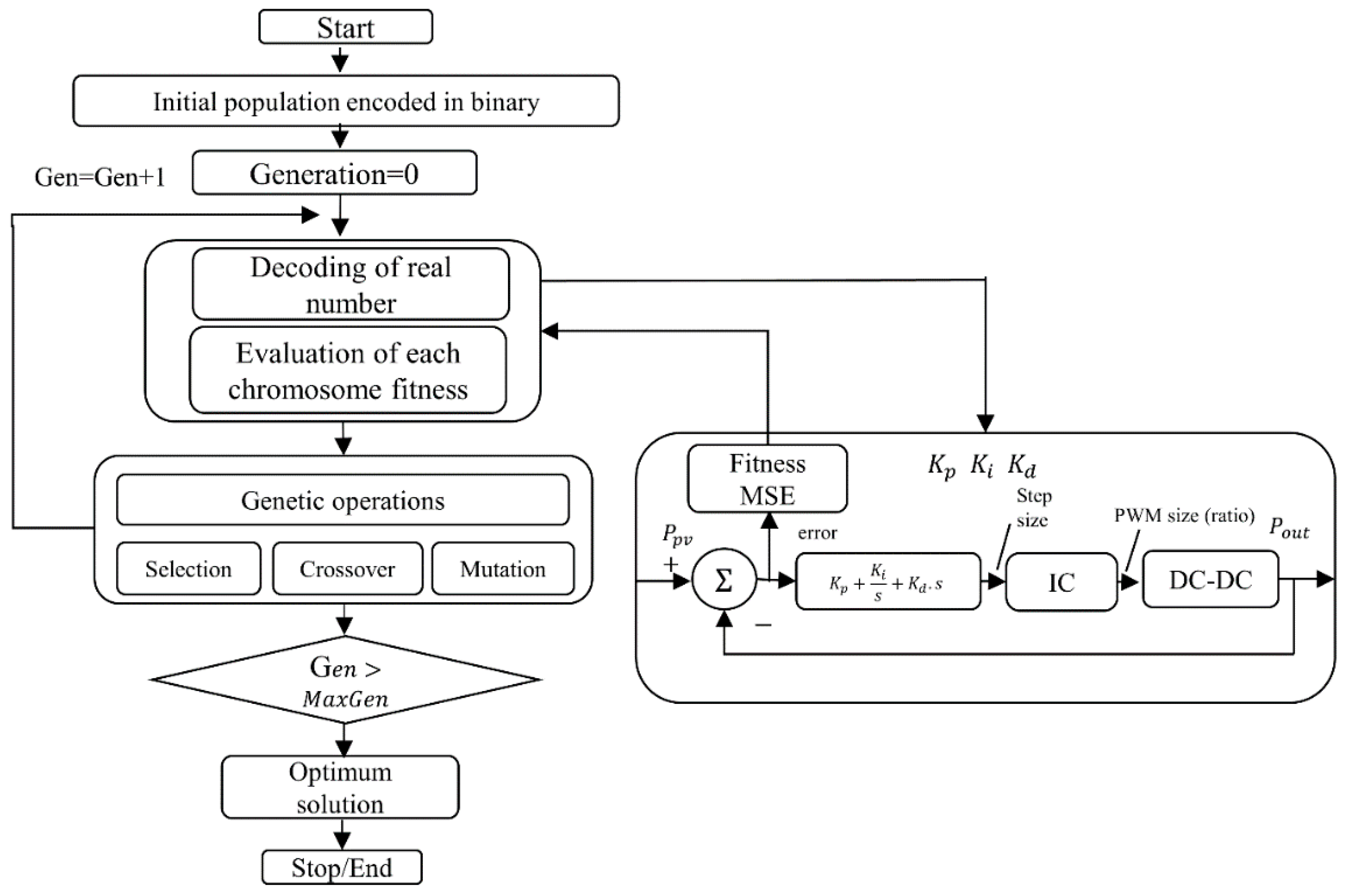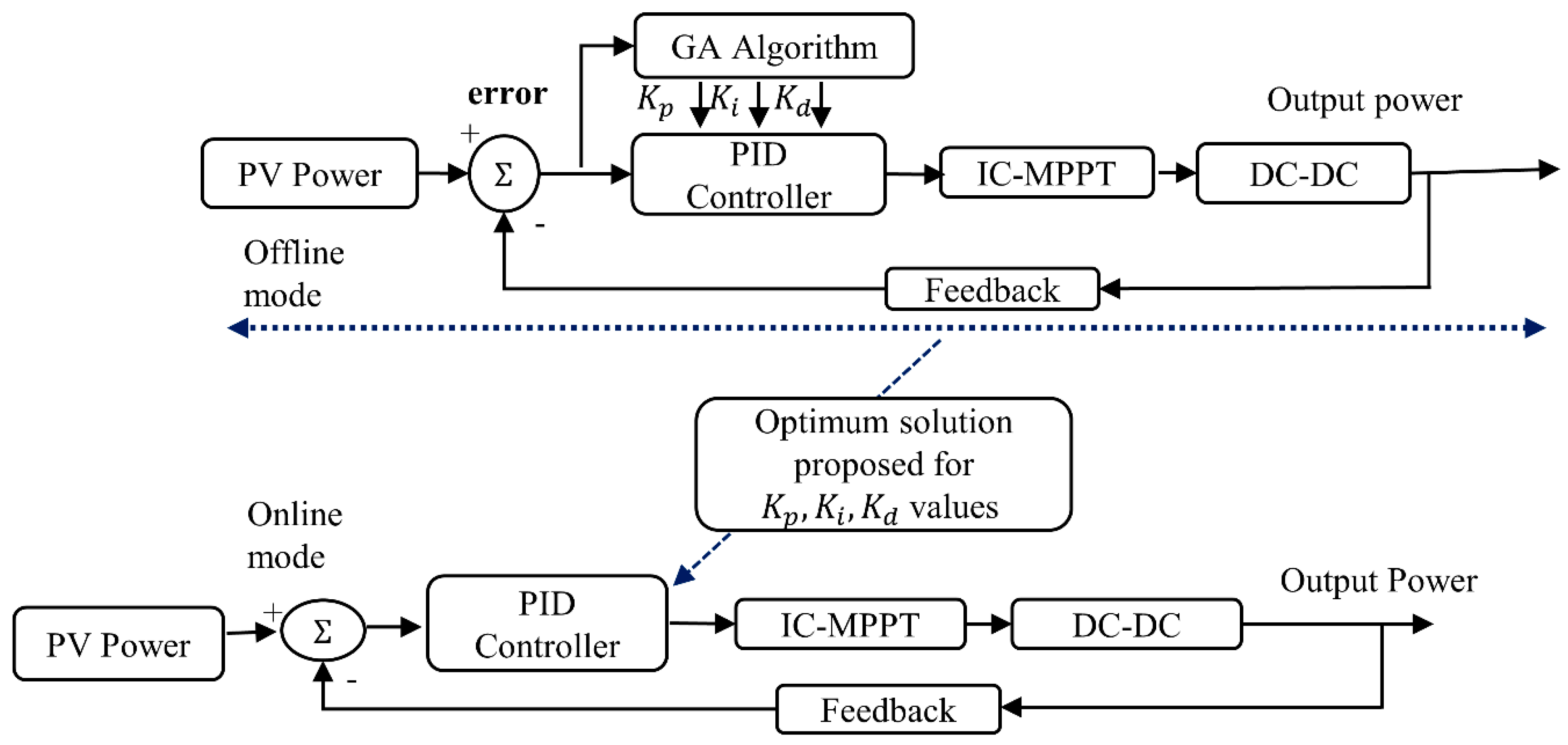1. Introduction
Nonrenewable fossil fuel-based energy has been the driving force of economies, recent advancements in technology, the availability of resources, global warming, and changing economic models and the depletion of conventional resources [
1] has pushed governments and researchers to come up with novel ideas to address all the issues in single solution [
2]. Renewable resources are nowadays a significant addition to the ever-increasing demand for energy [
3]. Biogas, wind, solar, and wave energy are emerging at a fast pace and, among these, solar stands out due to its high efficiency, low maintenance cost, and scalability. Renewable energy is the need of the hour. Solar energy is expected to provide 1/3 of the world’s electrical energy demands by the year 2060. All other forms of renewable energy resources are highly restricted to geographical availability. Wind, geothermal, and tidal wave energy are highly localized. The only form abundant enough throughout the globe is solar energy. Rapidly falling manufacturing prices, technological improvement, favorable governmental legislation, job creation, environmental concerns, and a low carbon footprint are the reasons we have seen in recent years a tremendous increase in solar energy utility [
4]. Academics have researched it in this regard. In the year 2018, an 8.3% increase in renewable generation was recorded. In solar energy, the focus of research work is on photovoltaics, concentrated solar power, manufacturing, and scalability.
Among all renewable energy sources (RESs), solar is a noise-free, pollution-free, and inexhaustible resource. PV systems are a growing industry. Since the advent of the solar cell in the 1970s, the efficiencies of solar cells increased significantly. Solar energy is reliable, cheap, and abundant. Operating temperature and irradiance significantly affect the power an array can deliver [
5]. The solar cell parameters are nonlinear by nature [
6]. For a given pattern of shaded irradiance, the maximum available power is associated with a unique point on the power-voltage (P–V) curve, commonly known as the global maximum power point (GMPP), as shown in
Figure 1 and
Figure 2. The control action is applied to force the PV system to operate at the GMPP with the highest efficiency possible. MPPT increases output power significantly. Dynamic irradiance complicates the task of maximum power point tracking (MPPT) due to the existence of multiple local maxima (LM) [
7]. The classical perturb and observe (P&O) and incremental conductance (IC) cannot distinguish between local solutions due to a single point of operation. At LM, P&O and IC produce oscillations and cause the dissipation of available power. To minimize oscillations, the step size is reduced, which takes a toll on convergence speed. On the other hand, a larger step size, although increasing rise time, results in higher oscillations in the steady state. So, there is a tradeoff between convergence speed and efficiency.
The effects of changes in temperature and irradiance are shown in
Figure 1 and
Figure 2. The irradiance has significant effects upon the current output (
). The magnitude of output power is directly proportional to irradiance intensity. The temperature has a predominant effect upon the MPP point and voltage, specifically open-circuit voltage (
). The output power is inversely proportional to the operating temperature [
8].
A PV system is shown in
Figure 3. A DC-DC boost converter is utilized for load interface and control action via a pulse width-modulated (PWM) control action provided by the duty cycle.
Photovoltaic characteristics are dependent upon irradiance, weather conditions, operating temperature, manufacturing technology, and mounting techniques [
9]. Photovoltaic resources have been utilized in domestic PV systems, commercial solar parks, satellites, and remote small-scale utilities [
10]. The efficiency of a PV system is a combination of the PV array (17–42%), inverter (up to 95%), and MPPT (98%) [
11]. Modern control systems focus on MPPT to improve efficiency. Already existing systems also utilize improvised control with updated algorithms to maximize output. MPPT techniques are classified into offline, online, and hybrid methods. The offline methods make use of predefined parameters and mathematical models of a PV array to track MPPT and do not consider actual output power. The drawbacks of such systems are that they cannot detect the maximum power point during rapidly changing irradiance. Online methods, i.e., incremental conductance (IC) [
12], perturb and observe (P&O) [
13], and hill climbing (HC), measure the actual output power. The input and output power difference is utilized for decision making. Direct control is utilized to decide to either increase or decrease control parameters. The hybrid methods are applied in two steps. In the first step, general regression neural networks (GRNN), genetic algorithms (GAs), fuzzy, or artificial neural networks (ANNs) integrated with PID controllers are optimized according to the desired parameters. The second step involves the usage of optimized parameters for typical MPPT control action [
11,
12,
14,
15,
16,
17,
18,
19,
20,
21,
22,
23].
Although these methods are effective in tracking GM, there are some problems, like multiple LM, steady-state fluctuations, and oscillations that cannot be tackled. Heuristic algorithms like particle swarm optimization (PSO) and multiple knapsack (MKP) are successfully used for the accurate identification of global maxima (GM) [
24]. In hybrid models of MPPT, advanced methods are used to maximize PV outputs. P&O, HC, and IC are the most common MPPT techniques because of their simplicity of implementation and integration with multiple heuristic algorithms to utilize power management controllers with renewable energy resources effectively.
Starting from the development of the PV mathematical model, different techniques are used to develop a comprehensive mathematical model of PV cells and arrays. This modeling is done based on the predefined characteristics of the module. A more advanced approach also considers the real-time changes in P–V characteristics due to temperature, changes in resistances due to load, etc. however, a PV cell equivalent circuit model, single diode model, double diode model, simplified PV model, and current source model are used to emphasize different controlling techniques in different types of MPPT algorithms [
25].
The development of intelligent control and nature-inspired heuristic algorithms has enabled us to tackle problems like hotspot formation, non-uniform temperature spikes, partial shading, and other encapsulation failures that cause a loss of output power in a standard module. A defected module degrades the performance of the array, and consequently the whole system starts to underperform.
A PID controller is utilized independently or in combination with P&O and IC to enhance the transient and steady-state responses. To further enhance the output power and find global maxima, PSO, GAs, and ant colony optimization (ACO) are used. The hybrid approach to tune PID-PI controllers and DC-DC converters to obtain maximum power has been studied in several papers and they show the superior performance in terms of computation power [
26,
27,
28].
Modern controlling action includes robustness, accuracy, and the fast tracking of MPP. Variable step size, fuzzy logic controllers (FLZ), Hybrid particle swarm optimization (HPSO), neural networks (NNs), and GRNNs are utilized to implement real-time control action. Our study focuses on the utilization of a modified GA to fine-tune a PID controller to optimize boost converter output for tracking MPP [
29].
An ANN-PI [
30] controller is compared with IC in [
31]. GMMPT PSO [
32]-based models are reviewed. An MPPT controller and its results are compared, exhibiting a better performance of ANN-PI, especially under partial shading conditions (PSCs). An ANN-PI controller in [
30] is compared with an IC MPPT controller, and the results show a better performance of ANN-PI, especially under PSCs. In [
33], a GA-based MPPT is utilized. The work focuses on avoiding LM conventional MPPT issues with a GA-based GM-based algorithm to avoid trapping the controller in LM. As for a P&O system embedded in a GA, this system does not need pre-setup and can be applied to any PV model. The successful tracking of MPP is achieved by locating global maxima [
34]. In [
35], a GA is resettled/reinitialized at the start of every population, raising the question of genetic pool and crossover. The initial population is reset in case of a large change in parameters like irradiance, temperature, or load, which have to be compensated. The method of introducing an extremely small series resistance in the mathematical model along with high crossover and mutation probabilities provides similar functionality. Although it can help to find global maxima in a very small population, in case of higher mutation and crossover steady-state responses, overshoot can be significantly higher. The larger population requires more computational power. Ahmed et al. in [
36] compared the performance of a GA with GA-ANN power tracking efficiency while providing a better solution. Still, a lag in initial controlling action by the GA-ANN is observed because of the first few iterations, during which control action is not optimized. Although there are transient state lags, the steady-state response is better as compared to an ANN. This is the reason PID-GA tuning has been preferred, which makes use of not only predefined control action initially but it is also fine-tuned as the control action time progresses [
37]. Chicken swarm optimization (CSO) is a new genetic algorithm based upon a biological algorithm in which initial positions are arranged in chaotic sequence. Using this technique, the risk of falling into an LM trap is avoided. Multiple peak curves are detected effectively and global maxima tracking is done in a stable manner [
38].
In light of the literature review, the existing techniques lack efficient MPPT tracking, slow convergence, and exhibit oscillations around MPP. The common requirement from an MPPT controller is fast GM tracking, high efficiency, robustness, and zero oscillations around MPP. The proposed GAIC MPPT controllers successfully overcome the shortcomings of existing P&O controllers by the adaptive change in step size of the modified IC. This is achieved by the offline tuning of PID gains by the GA to enhance the online step size of the IC using GA. The comparative analysis shows the effectiveness under fast varying irradiance and temperature case studies.
3. Modified GA-IC
Many researchers have successfully implemented the P&O algorithm for MPPT [
22,
45]. Although P&O successfully tracks with reasonable efficiency, in MPPT, it oscillates back and forth and causes significant steady-state errors [
12]. On the other hand, the new IC has the advantage of the determination of MPP and the IC-based algorithm proposed has overcome the shortfall of P&O. The ratio of change in output conductance is equal to the negative output conductance. Conductance is an electrical term and is a ratio of current to voltage as given by Equation (5). At the MPP, the slope of the curve is zero [
46].
The change in output power with respect to voltage is given by Equation (6).
3.1. Proposed GA-Based Adaptive Step Size IC MPPT
The main objective of the PV control system is to provide maximum output power for given weather irradiation and temperature conditions. Energy optimization for the load is done by using a DC-DC converter that provides a controlling interface between the PV array and load. The duty cycle is utilized to produce a reference voltage for DC-DC boost converter pulse width modulation (PWM). The duty cycle is modified by adding a fixed step size change to perform the controlling action. This works presents a novel modified step size technique that utilizes a modification in the step size of classical IC. GA is used to optimize the gain of the PID controller, which alters the magnitude of step change (∆d) in both transition and steady states. This system is presented in the form of a block diagram in
Figure 5a.
3.2. Genetic Algorithm
In biological evolution, species, depending upon their positive or negative success in reproduction and survival in a particular environment, are successfully able to reproduce further and pass their traits to future generations. Because the generation of variety and differential survival through reproduction, evolution takes place. This is the basic biological evolution concept inspired by evolutionary computation (EC). Genetic algorithms are computational models inspired by evolution. The potential solution to a problem is encoded in chromosomes. Each chromosome carries a unique set of traits, i.e., a solution for the application of recombination operators to preserve critical information. Just like NNs, the GA is also considered as a function optimizer. To date, GAs have been applied to a broad range of applications. The widespread applicability, inherent parallelism, and global perspective are the main reasons for the popularity of GAs in the search for and optimization of problems.
3.3. GA-Based Tuning of PID Controller
A PID controller is utilized as an indirect control action. Each control parameter is encoded as a binary string of chromosomes. The PID controller is mathematically given by Equation (7) [
47].
where
is the proportional gain,
is the integral gain, and
is the derivative gain. Optimization is done to minimize the
given by Equation (8).
where
is the error in terms of reference or set point (SP) and process value (PV),
is the instantaneous time, and
is the variable of integration that takes values from
at the instant of operation.
A genetic algorithm is used to tune the gains of the PID controller. Parameters , and are encoded as chromosome binary strings. Each chromosome is assigned 16 bits. The total length of the string is 48 bits. Selection is applied to a group of chromosomes to obtain a mating pool. In the GA, the main reason for obtaining a mating pool is to select healthy individuals for reproduction. In our case, the selection of parents is done on the basis of fitness proportionate selection, roulette selection assigns a fitness to a possible solution in a population which is associated with the probability of the selection of each chromosome. The solutions with higher fitness are less likely to be eliminated. It gives a healthy first generation to begin with.
3.4. Operation of the GA
The GA starts with a string of fixed length code, representing possible solutions. Potential solutions are known as chromosomes. Each chromosome is tested against a fitness function and is assigned a fitness value. Afterward, three different operations are applied to the population of chromosomes. These operations are:
Selection: the selection is applied to the population to obtain the fittest mating pool.
Crossover: crossover is an operation applied to the strings of the mating pool in which two randomly selected strings swap some portion of the string between each other.
Mutation: in mutation, the lower bits of string data of an individual chromosome are inverted, 0–1 and 1–0, which generates newer traits and diversity in the solution space.
The iteration of these operations gives rise to a new generation. Every new generation represents a better result or optimization of the solution. At the end of one iteration, the stopping criterion is checked. The stopping criterion can be a predefined time limit, the number of iterations, or population convergence. A flowchart of a GA is shown in
Figure 6.
3.4.1. Crossover
For the next generation, crossover is performed, and new individuals contain genetic material from both of the parents. We applied single point crossover in our case, as illustrated by
Figure 7. Mutation, as shown in
Figure 8, is a genetic operation by means of which it is ensured that bio-genetic diversity in next generation is preserved.
3.4.2. Mutation
The fitness is calculated for each chromosome by an equivalent real number binary magnitude representing the gain signal of the PID signal. Each iteration gives a set of values passed to the PID controller in order to compute the control signal of the system, as shown in
Figure 9. The role of mutation is to help us explore more of the solution space. Mutation is introduced by complementing the lower nibble bits of the binary string. It stops the population from falling into local minima.
3.4.3. Fitness Function
The fitness function is presented by Equation (9). Most fitness functions make use of overshoot, rise time, settling time, steady-state error, or a combination of any of these criteria, and any one of these can be potential fitness function. We have made use of a combination of scaling factor and integral square error (ISE) [
40]. The parameters
and
are both given equal preference, i.e.,
Peak overshoot is calculated using Equation (10).
Overshoot is calculated using Equation (11).
ISE is calculated using Equation (12).
3.5. Experimental Implementation of Modified GA-IC MPPT
Table 4 gives the parameters of the GA under implementation.
Table 5 presents the optimized sets of the PID controller. The size of the population increases efficiency but takes a toll on computation, so it does iterations. The crossover probability makes use of the transfer of characteristics being transferred to the next generation. Mutation introduces new traits. It diversifies the solution and eliminates stagnation in each iteration.
Figure 9 gives the detailed flow of proposed MPPT control action.
Up till now, the GA has been utilized to optimize the performance of the PID controller, and at this stage, the PID controller and GA are operated in offline and online modes.
The updated IC block on each step generates the corresponding variable duty cycle signal. The ratio of the duty cycle is the controlling factor of the DC-DC boost converter, which regulates the output of the PV array at MPP.
